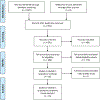Changes From Baseline in Patient- Reported Outcomes at 1 Year Versus 2 Years After Rotator Cuff Repair: A Systematic Review and Meta-analysis
- PMID: 34473586
- PMCID: PMC10510728
- DOI: 10.1177/03635465211023967
Changes From Baseline in Patient- Reported Outcomes at 1 Year Versus 2 Years After Rotator Cuff Repair: A Systematic Review and Meta-analysis
Abstract
Background: Most orthopaedic journals currently require reporting outcomes of surgical interventions for at least 2 postoperative years, but there have been no rigorous studies on this matter. Various patient-reported outcome (PRO) measures (PROMs) have been used to assess the status of the shoulder after rotator cuff repair (RCR).
Hypothesis: We hypothesized that the mean shoulder-specific PROMs at 1 year improve substantially over baseline but that there is no clinically meaningful difference between the mean 1- and 2-year PROMs after RCR.
Study design: Meta-analysis; Level of evidence, 2.
Methods: We conducted a systematic review of published randomized controlled trials (RCTs) and prospective cohort studies (level of evidence 1 and 2) reporting the shoulder-specific American Shoulder and Elbow Surgeons (ASES), the Constant, or the Western Ontario Rotator Cuff (WORC) Index scores at baseline, 1 year, and 2 years after RCR. The methodologic quality of studies was assessed. Also, the random effects meta-analyses of changes in PROMs for each of the first and second postoperative years were conducted.
Results: Fifteen studies (n = 11 RCTs; n = 4 cohort studies) with a total of 1371 patients were included. Studies were highly heterogeneous, but no visual evidence of major publication bias was observed. The weighted means of the baseline PROMs were 46.2 points for the ASES score, 46.4 points for the Constant score, and 38.8 points for the WORC Index. The first-year summary increments were 41.1 (95% CI, 36.0-46.2) points for the ASES score, 34.2 (95% CI, 28.8-39.6) points for the Constant score, and 42.9 (95% CI, 37.3-48.4) points for the WORC Index. In contrast, the second-year summary increments were 2.3 (95% CI, 1-3.6) points for the ASES score, 3.2 (95% CI, 1.9-4.4) points for the Constant score, and 2 (95% CI, -0.1 to 4) points for the WORC Index.
Conclusion: All PROMs improved considerably from baseline to 1 year, but only very small gains that were below the minimal clinically important differences were observed between 1 year and 2 years after RCR. This study did not find any evidence for requiring a minimum of 2 years of follow-up for publication of PROs after RCR. Our results suggest that focusing on 1-year PROMs after RCR would foster more timely reporting, better control of selection bias, and better allocation of research resources.
Keywords: follow-up; outcomes; patient-reported outcome measures; rotator cuff repair; shoulder surgery.
Figures




References
-
- Abrams GD, Gupta AK, Hussey KE, et al. Arthroscopic repair of full-thickness rotator cuff tears with and without acromioplasty: randomized prospective trial with 2-year follow-up. Am J Sports Med. 2014;42(6):1296–1303. - PubMed
-
- Angst F, Schwyzer HK, Aeschlimann A, Simmen BR, Goldhahn J. Measures of adult shoulder function: Disabilities of the Arm, Shoulder, and Hand Questionnaire (DASH) and its short version (QuickDASH), Shoulder Pain and Disability Index (SPADI), American Shoulder and Elbow Surgeons (ASES) Society standardized shoulder assessment form, Constant (Murley) Score (CS), Simple Shoulder Test (SST), Oxford Shoulder Score (OSS), Shoulder Disability Questionnaire (SDQ), and Western Ontario Shoulder Instability Index (WOSI). Arthritis Care Res (Hoboken). 2011;63(suppl 11):S174–S188. - PubMed
-
- Avanzi P, Giudici LD, Capone A, et al. Prospective randomized controlled trial for patch augmentation in rotator cuff repair: 24-month outcomes. J Shoulder Elbow Surg. 2019;28(10):1918–1927. - PubMed
-
- Boutron I, Moher D, Tugwell P, et al. A checklist to evaluate a report of a nonpharmacological trial was developed using consensus. J Clin Epidemiol. 2005;58(12):1233–1240. - PubMed
Publication types
MeSH terms
Grants and funding
LinkOut - more resources
Full Text Sources
Medical
Miscellaneous

